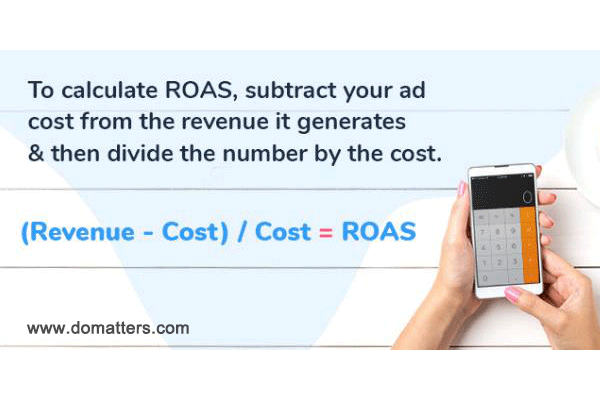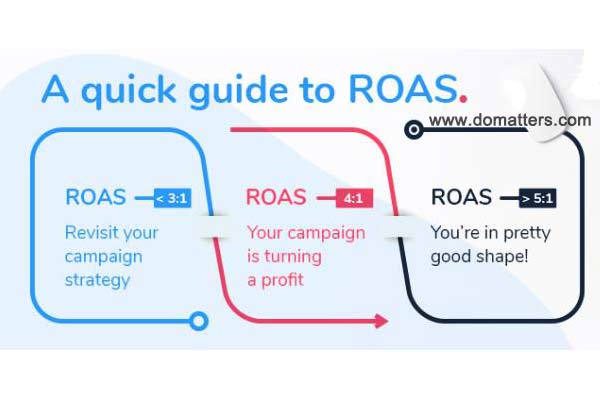What is RoAS?
RoAS is the acronym for Return of Advertising Spend, which means ”广告支出回报” in Chinese. It is mainly used to measure the return on your PPC ads investment.
If you invest X dollars in this advertising channel or advertising campaign, how much revenue will you get? This indicator can answer you.
It measures how many dollars you can get for every dollar you spend on campaigns, ad groups, ads or keywords. If your marketing channels or activities do not generate target profits, then your investment of time and resources is not worth it.
A simple way to calculate RoAS is to subtract its cost from the revenue it generates, and then divide by the cost. That is, the formula is as follows:
RoAS=(Revenue-Cost)/Cost

Please note that advertising expenditures may include other costs incurred when you create ads or generate sales, such as design costs, supplier/partner fees or affiliate commissions. If it is for e-commerce business, then RoAS is very simple. Because you can track every click. For example, by tracking purchases to calculate conversion events in a campaign, you can view the revenue generated by clicks on specific campaigns, ad groups, ads, or keywords.
Since the association between campaigns and conversion events is very straightforward for e-commerce business, RoAS is an efficient indicator for identifying the best performing campaigns.
What can you know from RoAS?
If your PPC campaign is not generating sales and making money, then your advertising marketing plan needs to be adjusted!
On the one hand, RoAS is a key indicator to measure the need for improvement to promote sales and increase profits.
Although many indicators can indicate different aspects of advertising effectiveness, they do not directly link click-through rates to your profits like RoAS. For example, the click-through rate will not tell you the quality of these clicks. You have to pay for the clicks but not necessarily generate sales. The conversion data does not include the total cost of running ad campaigns and making sales. If the cost of each sale of the campaign is high (for example, you attract a large number of potential customers who return), then you may lose money every time someone makes a purchase!
On the other hand, RoAS shows the direct relationship between cost and profit, and provides you with the necessary enlightenment. You can dial in different variables to reduce costs and increase profits.
What kind of RoAS is good?
Although there are no strict rules to define “good RoAS”, a simple rule of thumb is that RoAS should be at least 3:1. Of course, every company is different, and some companies may need a 10:1 RoAS to make a profit.
If RoAS is below 3: 1, you should re-examine your campaign strategy.
If RoAS is 4:1, your campaign is generating profits;
If the RoAS is 5:1, your campaign will create higher profits, you can analyze which factors are effective, and then go deep!

What does RoAS mean for e-commerce companies?
If your RoAS does not reach the ratio that makes your business profitable, you can adjust all the factors that affect the equation to increase the RoAS index. (Domatters will tell you how to do this later in the article).
In addition, you can combine RoAS with customer lifetime value to gain insight into future budgets, strategies and overall marketing directions.
How to improve the return on investment of PPC campaigns?
Do you remember the formula for calculating RoAS mentioned above? RoAS=(Revenue-Cost)/Cost. There are only two variables in this formula. As long as you maximize revenue and/or reduce costs, your RoAS will be higher.
How to improve the RoAS of PPC ads campaigns?
One. Maximize your income from PPC activities
You must bring more high-quality traffic to your e-commerce website and encourage visitors to make purchases to increase revenue. Here’s how to convert as many clicks as possible into transactions:
* Optimize audience positioning:
You need to identify the segments that are most likely to convert into buyers with high customer lifetime value, and display the products that are most relevant to each segment.
* Improve the ad copy:
You need to make sure that the ad copy can “talk” to the audience segment, highlight special offers and increase the sense of urgency to attract attention. For example, the discount deadline.
* Locate buyers with high purchasing intentions:
You need to locate search terms commonly used by consumers who are ready to make a purchase. For example, include long-tail keywords for specific brands, colors, or sizes, as well as words such as discounts or free shipping.
The ad copy matches the content of the landing page:
Domatters recommends that you create a dedicated landing page that matches the content of your ad to provide a consistent user experience and minimize conversion friction.
* Optimize the mobile device side:
As more and more consumers shop on mobile devices, it is important to optimize mobile devices. After all, you should not want visitors to leave your website just because it is not optimized for mobile devices. Otherwise, you are paying for clicks without creating any sales!
* Improve the quality score of the campaign:
The high quality score means that the advertisement is more relevant to the landing page, which can help your advertisement rank higher in relevant searches and obtain higher quality traffic.
* Use redirect ads:
It boosts response by up to 400% through a remarketing strategy that can show ads to consumers who have visited your e-commerce website and are interested in specific products. You can also reduce cart abandonment by retargeting shoppers who left their products in the shopping cart.
* Implement the conversion rate optimization (CRO) strategy:
This allows as many visitors as possible to make purchases, so you can reduce the number of clicks that do not generate revenue. Use various conversion optimization strategies to reduce friction in the purchase path and increase sales.
* Increase the average order value (AOV):
It can increase the consumption of each shopper through up-selling, cross-selling and bundling sales in order to generate more revenue for each click.

Two. Minimize the cost of PPC advertising
It reduces the cost of campaigns by reducing wasteful spending and getting higher quality clicks with lower bids. It includes but is not limited to the following aspects:
* Balancing competitiveness and cost:
You need to understand the keywords you are bidding on. The best-performing keywords may bring traffic, but fierce competition may increase your cost per click, which can significantly reduce your profits.
* Optimize the campaign settings:
Narrow your targeting based on geographic location, language, network, device, etc., and only show your ads to audiences with the highest conversion potential.
* Keywords with poor evaluation results:
Pause keywords or placements that are not driving high conversion traffic, and check the analysis of different traffic sources, timelines, and networks, so you won’t pause channels that actually perform well.
* Add long tail keywords with high conversion rate:
To do business in China, you can provide high-quality long-tail keywords through the keyword research done by the Domatters Digital China Marketing Agency for your products. You can check which long-tail keywords will trigger your ads and add them to your campaign to target high-quality potential customers at low cost.
* Negative keywords:
Use the information in the keyword research report conducted by the Domatters Digital China Marketing Agency for your products to determine the keywords that generate clicks but not conversions, and add them as negative keywords to your campaign so that you don’t Pay for clicks that do not convert.
* Display advertising price:
Eliminate shoppers who don’t fit your pricing strategy so you don’t have to pay for their clicks.
* Show ads at a specific time:
You need to know when the most conversions occur on your website and set your ads to run only during these specific time periods. If you sell seasonal products, you can adjust your campaigns on a monthly basis.
* Pause campaigns that have no profit:
Review your analysis frequently and pause campaigns that have not yet generated sales. To
* Evaluate other costs:
Evaluate the expenses associated with running the ad-for example, graphic design, copywriting, ad management, affiliate commissions, etc.-to see if there is any waste that can be eliminated.
In order to obtain the correct data to fine-tune your PPC campaign, please make sure that the tracking is set up correctly to collect the correct data. In addition to traffic-centric metrics (such as clicks, click-through rate, and cost-per-click), be sure to track the conversion operations generated by these clicks, namely sales and revenue.
In addition, perform A/B testing and set up custom reports to help you focus on important metrics. Data-driven, systematic PPC activity management is the key to improving RoAS and profits.









